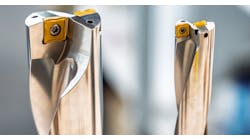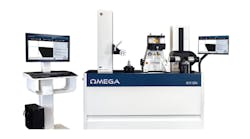New Kennametal spindle connections improve reliability, productivity for Cincinnati’s high-volume titanium profiler
When a demanding industrial sector like commercial aircraft manufacturing goes into a period of sustained expansion, there is pressure throughout the supply chain to maintain quality standards and production schedules. Machine tool builder Fives Cincinnati realizes this: its Hebron, Ken. plant produces Cincinnati machining centers, composites fiber-placement systems, and multi-spindle Cincinnati profilers. With over 650 profilers in the field all over the world, it claims that there is no commercial jet now in service that its profiling technology has not helped bring into service.
Available in three- and five-spindle gantry configurations, its latest-generation Cincinnati XTi Profiler impresses in many ways. Designed for manufacturers that process multiple materials, 7000-rpm spindles can cut aluminum and steel, and high-torque (2,523 Nm) spindles are available for processing titanium and other hard alloys. More than that, it describes the XTi as ‘the only multi-spindle platform available for titanium roughing,” and claims that is metal-removal rate (MRR) sets the record for machining titanium at over 100 cubic inches per minute.
With 4,267 mm (expandable in increments of 3,658 mm) in the X-axis, 3,683 mm in Y, and 711 mm in Z, the XTi now has the option of Kennametal Inc.’s KM4X100 spindle connections.
For profiling or milling, in larger or small increments, titanium’s hardness makes metal removal a constant challenge. Machining hard alloys while adding the pressure of improving production efficiencies means maximizing metal removal in the face of low cutting speeds and significant cutting forces.
Fives Cincinnati (among other machine tool builders) has responded to the challenge by improving the machines’ stiffness and spindles’ damping qualities, to minimize machine vibration that undermines part quality, product throughput, and tool life. These advances have helped to raise productivity rates, but tool-spindle connections have remained a design detail requiring more reliability and durability.
The “handshake” between the machine tool and the cutting tool determines how much material the machine can remove on a given operation, because this interface must withstand high loads while remaining rigid, up to the point that tool deflection is too high or chatter begins.
Spindles may be able to transmit a considerable amount of torque, but cutting forces also generate bending moments that will exceed the interface’s limits prior to reaching torque limits. This becomes obvious in end-milling applications, where projection lengths are typically greater -- the limiting factor is the spindle interface’s bending capacity. For example: an indexable helical cutter with 250 mm (9.84 in.) projection from spindle face, 80 mm (3.15 in.) in diameter, generates 4,620 Nm (3407.5 ft. lbs.) of bending moment and less than 900 Nm (663.8 ft. lbs.) of torque when removing 360 cm3/min of Ti6Al4V at RDOC of 12.7mm and an ADOC of 63.5mm.
By combining high clamping force and optimized interference levels, Kennametal’s next-generation spindle connection KM4X provides a robust connection, extremely high stiffness, and bending load capacity. For titanium processors, this means greatly improved performance in machining high-strength alloys and other materials, enabling extremely high metal removal rates and more completed parts per day.
Together with Kennametal senior account manager Mike Malott, Fives Cincinnati applications engineer Robert Snodgrass began evaluating KM4X approximately four years ago. “The engineering is impressive,” he recalled. “It definitely allowed us to start thinking that there’s more to machine design, that a stiffer spindle helps meet customer demand for more effective metal cutting and increased throughput.”
“Remember, typical aero structure components start out as forgings with much of the material being removed to achieve finished part specifications,” said Kennametal vice president Mark Huston. “The “buy-to-fly” ratio -- the weight you buy in raw material versus the weight that flies in finished form can be 4:1, 8:1 or more, depending on the component.”
First-generation Cincinnati profilers achieved an MRR of 4 in.3/minute in titanium, due to machine structure and tool-spindle connection limitations. With the XT-generation of Cincinnati profilers and face-contact HSK 125 spindle connections, the MRR increased to 50 in.3/minute. With the KM4X100, the MRR doubled to 100 in.3/minute.
“Even at a 100 cubic inches per minute, our benchmark testing for the XT profilers using the KM4X were well below the machine’s theoretical limits for bending moment resistance,” Snodgrass added. Noting that previous-generation tests employed large CAT60-taper toolholders, he compared using the 50-taper version to “driving a tank versus an SUV.” The KM4X achieved double the metal removal rates versus the 60-taper toolholder. Compared to CAT50, HSK100, or KM4X100 the CAT60 is almost twice the weight.
“This changes spindle and machine design a ton,” said Ken Wichman, Fives Cincinnati product manager. “Many gantry machines have manual tool exchange even though automatic tool exchange/storage is available. The enhanced bending moment resistance of the KM4X allows lighter tooling when compared to a CAT or HSK tool with an equivalent bending moment resistance. Ergonomically, this is a huge benefit to the operator. For customer’s choosing automatic tool exchange/storage, the smaller KM4X can accommodate more tools in a given footprint.”
“We pride ourselves in keeping customers productive,” added Fives Cincinnati vice president Mark Logan. “Not only is a more powerful spindle connection like KM4X changing new machine design, it also can be a significant boost for existing machines in the field. This gives us the chance to offer a notable upgrade in retrofits while still pushing the limits on profiler models to come.”








